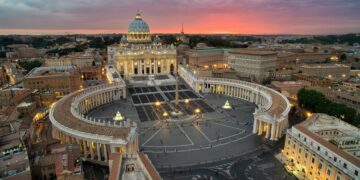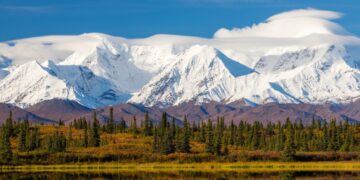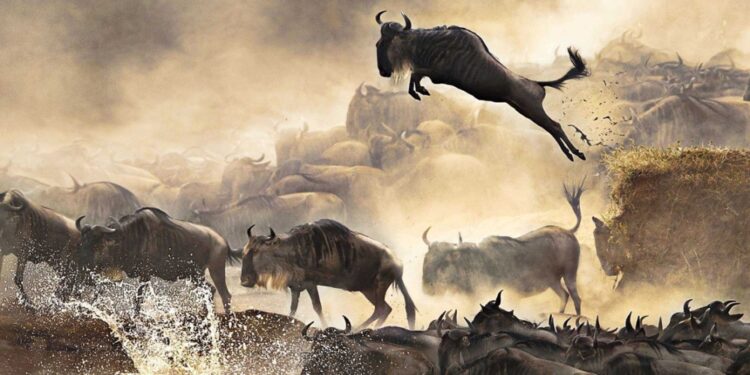Massive glaciers, staggering mountains, plains dotted with wild animals – we sure live in a big, beautiful world. While man-made sites like the ancient Egyptian pyramids, Great Wall of China, and Colosseum undoubtedly fill us with awe, many of the most impressive sites on the planet were crafted by Mother Nature herself. And while pinpointing all of Mother Nature’s greatest hits could take a lifetime, we think these out-of-this-world landscapes and awe-inspiring wonders, need to move to the very top of your travel list.
Here are the top 20 natural wonders of the world.
1. Great Wildebeest Migration
Maasai Mara, Kenya and Serengeti, Tanzania
The Great Wildebeest Migration, the world’s largest migration of wildlife, is a popular event to witness in Kenya’s Maasai Mara. While migration happens year-round, it’s in July and August that the wild beasts cross the Mara River. The migration happens across the northwestern Tanzania and extends to southwestern Kenya. The region hosts the largest mass movement of land mammals on the planet and one of the most breathtaking events in the animal kingdom.
Every year, over 2 million wildebeest, zebras, gazelles and other animals make a 300 mile round trip from the southern Serengeti in Tanzania to the northern edge of the Maasai Mara national reserve in Kenya in pursuit of greener pastures. The great migration is probably Africa’s greatest safari spectacle and the most exceptional natural wonder of the world.
2. Amazon Rainforest
Bolivia, Brazil, Colombia, Ecuador, French Guiana (France), Guyana, Peru, Suriname, and Venezuela
If you lived long enough to count that high you could count 390 billion trees in the Amazon Rainforest. This statistic is mind-boggling to be sure, but then the Amazon Rainforest is one awesome piece of nature covering about three quarters of the Amazon River basin. It’s the world’s largest tropical rainforest. 60% of the rainforest is located in Brazil with sizable chunks in Peru and Colombia, bordering countries have small shares. For sure the rainforest is loaded with unique flora and fauna.
3. Ha Long Bay
Vietnam
Located in northeastern Vietnam, Ha Long Bay resembles a scene from a fantasy story, with its thousands of limestone karst islands of different shapes and sizes. Ha Long means descending dragons which is indicative of the silhouette of the limestone outcrops that poke out from the water. Some of the islands contain lakes, while some are hollow with a colorful fairy land of grottos inside. An overnight boat trip is a spectacular way to experience the beauty of the bay and to see as many of the islands as possible.
4. Grand Canyon
Arizona, United States
Renowned the world over, the Grand Canyon needs no introduction. One of the largest canyons in the world, it really has to be seen to be properly appreciated. Whether you visit the north, south, east or west rim areas, it’s always a giant sculpture of light and shadow that barrels its way across an awesome landscape. Around the national park that encompasses it, there are a whole host of trails and viewpoints. Cape Royal on the north rim is a top vista for many major parts of the Grand Canyon. You can even reach down to the canyon floor over a mile down in some places via steep meandering trails.
5. Victoria Falls
Border of Zimbabwe and Zambia
If you thought that Niagara Falls was large, well Victoria Falls dwarfs it with its colossal curtain of water that stretches for 1,708 meters reaching 108 meters in height. It’s these epic proportions that make Victoria Falls the largest waterfall in the world. Breathtaking to the hold, the endless flow of water that tumbles over the cliff almost defies belief. Fittingly the cacophonous roar that rises from the gorge below in the fine spray that hangs in the air saw the falls named “the smoke that thunders” in the local lozy language. Nestled on the border between Zambia and Zimbabwe, Victoria Falls truly needs to be seen to be believed.
6. Mount Everest
Border of Nepal and China
The tallest summit on Earth, Mount Everest stretches a whopping 8,848.86 metres (29,031.7 feet) into the sky above the border of Nepal and China. Like the rest of the Himalayas, Mount Everest rose from the floor of the ancient Tethys Sea. It’s the highest mountain in the world and continues to grow today at the rate of a few millimetres each year. Mount Everest and the Himalayas were traditionally revered by the local people as the homes of the gods and were considered sacred. Ascending this mammoth Himalayan peak is an impressive feat attempted by few, and accomplished by even fewer.
7. Antarctica
Antarctica
Antartica on average is the coldest, driest and windiest continent on the planet, and has the highest average elevation of all the continents. Although about 98% of Antarctica is covered in ice, it’s technically a desert with very little precipitation. Antarctica is colder than the Arctic because much of the continent is more than 2 miles above sea level, and because the Arctic Ocean covers the north polar zone, transferring the ocean’s relative warmth through the ice pack. Sea life in Antarctica includes penguins, blue whales, orcas and seals.
8. Great Barrier Reef
Australia
The largest coral reef system on the face of the earth, the Great Barrier Reef is simply colossal. Stretching for over 1,400 miles it is remarkably visible from space, with 900 islands dotting this enormous ecosystem. Snorkeling and scuba diving are the best ways to experience the joys of the rich underwater world, while boat trips, kayaking and even helicopter rides offer another view of the reef’s gargantuan proportions. Gently sailing through the perfect turquoise waters, dolphins sea turtles and the reef itself visible below the waves is an unforgettable experience.
9. Aurora Borealis (The Northern Lights)
Iceland
An incredible natural phenomenon, the polar lights and their captivating colors, shapes and swirls appear when there is solar activity. The best chance to spot them will be in the winter, when the nights are longer. The further north you go and the further you travel away from cities the better your view will be. Besides watching them out of your window, you can also take tours into the wilderness to see the shimmering lights from secluded light-free spots and stay at cozy cabins and campgrounds.
10. Zhangjiajie National Forest
Hunan province, China
Located in northwest Hunan province, Zhangjiajie National Forest boasts some of the most impressive and spectacular landscapes in China. Part of the wooling mountain range, the scenic area is particularly famous for the thousands of pillars and peaks that punctuate the park. Often shrouded in mist, these karst formations look incredible, and many of them tower over 200 meters high. Covered in subtropical rainforest they rise above plunging ravines and deep gorges, with sparkling rivers, lakes and waterfalls found here and there.
11. Pamukkalle
Denizli, Turkey
Pamukkalle meaning cotton castle in Turkish is an unreal landscape in western Turkey famous for its white terraces. The terraces are made of travertine, a sedimentary rock deposited by water with a very high mineral content from the hot springs. People have bathed in its pools for thousands of years. The ancient Greek city of Hieropolis was built on top of the hot springs by the kings of Pergamon. The ruins of the bats and other Greek monuments can still be seen at the site.
12. Galapagos Islands
Ecuador
If you want to get a glimpse of what prehistoric animals may have looked like, head to the Galapagos Islands. The animals are like no other place on Earth, and include giant tortoises and scary-looking iguanas. They were the impetus for Charles Darwin’s controversial 19th century book On The Origin of Species. This archipelago of 18 major islands about 550 miles off the coast of Ecuador was formed and are still being formed by volcanic action.
13. Sahara Desert
Africa
The Sahara is the world’s largest hot desert covering most of Northern Africa, making it almost as large as the United States. Contrary to popular belief, large sand dunes form only a minor part of the Sahara. Most of the desert consists of largely barren rocky plateaus with very little sand. The Sahara receives less than 3 inches of rain a year on average. Even in the Sahara’s wettest areas it may rain only once or twice a week and not rain again for years.
14. Iguazu Falls
Border of Argentina and Brazil
Made up of some 275 different cascades falls and drops, Iguazu Falls on the Argentine-Brazilian border is the world’s largest waterfall system. As such it’s the only waterfall that can rival or possibly even surpass Victoria Falls. For almost 3 kilometers in total, gorgeous falls course over the Piranha Plateau with the undoubted highlight being Devil’s Throat Canyon. This is best witnessed from the Brazilian side’s viewing platform, where you are greeted with teeny sheets of water, a deafening roar, and a fine spray. With lush rainforests lying around it, the falls are a treat to visit. Visitors can take boat trips along the Iguazu River or explore the nearby paths and trails.
15. Yellowstone
Wyoming, United States
The granddaddy of American national parks, Yellowstone is the oldest in the United States and the world, having been founded in 1872 when it was first discovered. Stories of the magnificence of the area were passed off as lies and tall tales. You can see why erupting geysers here belt steam in water, such as the Clockwork Old Faithful. There are boiling hot springs like the Grand Prismatic Spring. Thanks to differing temperatures and minerals, as the water spreads out, this is a veritable rainbow of unbelievable colors. There’s even the Grand Canyon of Yellowstone, a natural wonder in granite. This place is a true icon of must-see nature.
16. Salar de Uyuni
Bolivia
Located in the Andes mountains, Salar de Uyuni is the largest salt flat in the world. The expanse of salt creates an unending white landscape during the dry season, but the area is most breathtaking in the rainy season when it’s covered in water. The reflection of a blue sky creates a spectacular and surreal landscape. One of the most unusual places to visit in South America it’s also a major breeding ground for flamingos.
17. Banff National Park
Canada
Canada’s oldest national park, Banff is chock full of awesome scenery. Set amongst the beauty of the Canadian rockies, the park contains several beautiful lakes including Lake Louise, the gem of the park and the much photographed Moraine Lake. It’s also a good place to see glaciers, ice fields, and wildlife including elk, deer, moose and bears. As a year-round tourism destination the park draws 3 million visitors annually. They come for the winter sports and summer hiking, and camping.
18. The Maldives
The Maldives
Located in the middle of the Indian Ocean, the idyllic Maldives archipelago is spellbindingly beautiful. Close to the equator, the Maldives has a warm and tropical climate that’s perfect for lazy beach days all year round. This low-lying island group is celebrated for its high level of luxury and emphasis on the slow life. Perfect for honeymooners, the Maldives designer accommodation is out of this world. Take your pick of underwater villas, over water villas and everything in between. There’s even an underwater restaurant for those looking to dine surrounded by schools of tropical fish. As relaxing is the key in the Maldives, you can spend your days sipping on cocktails and sunbathing interspersed with a diving excursion to keep things interesting.
19. Lake Baikal
Russia
The deepest and oldest lake on Earth, Lake Baikal is reputed to boast some of the clearest and cleanest waters around. To top it all off the enormous freshwater lake contains more water than all the great lakes in North America combined. With so many accolades to its name, it’s no wonder that Lake Baikal is nicknamed “the Pearl of Siberia”. While the lake makes for fabulous viewing when the summer sun glints off its dark waters, it’s no less impressive in the winter when it freezes up to 2 meters deep in parts. Whether it’s ice skating across the surface or hiking along the scenic shoreline, Lake Baikal is a nature lover’s dream
20. Wadi Rum
Jordan
In southern Jordan is, Wadi Rum, a desert valley known for its breathtaking scenery. There are no permanent settlements in the secluded desert region, but nomadic tribes do occasionally pass through. Although deserts are often imagined as dunes, Wadi Rum boasts sandstone mountains and towering granite cliffs. The distinctive reddish-orange colors that lend the area and other worldly quality, has brought several science fiction films here to replicate the red planet. Visitors can ride a camel across the amazing desert and camp out under the clear star-filled sky.


































































































































































































